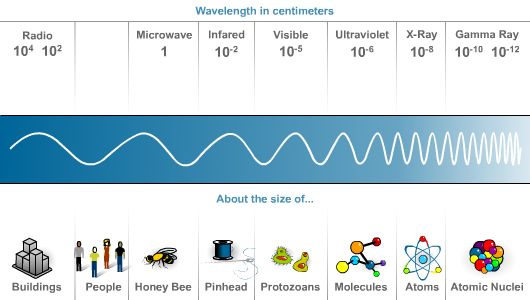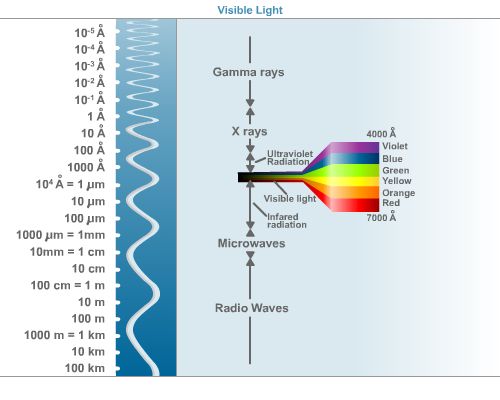

Friend and Foe
Taming the Wild Energies
We have the power! Whenever we turn on a computer, a cell phone, a stove,
a radio; light a match; get an x-ray for a broken leg, have a CAT-scan;
run a nuclear power plant, explode a hydrogen bomb, focus a laser beam,
or put on sunscreen, we are trying to tame electromagnetic radiation.
When it is your friend, it is being used by your TV to present glowing
images on a screen, or being used to pop popcorn in that bag in the microwave.
Right now, friendly electromagnetic radiation is in the lightbulb above
you. When it is your foe, it is in the form of X-Rays, Gamma Rays, or
even "Galactic Cosmic Rays" which can penetrate the cells of
your body and create cancers. As your foe, electromagnetic radiation comes
in the form of Uranium in the soil in the Rocky Mountains, or Radon in
your basement.
Electromagnetic energy is all around us. It moves at the speed of light.
It cooks our food, enters our eyes, bathes our skin and heats us, penetrates
our bodies, threatens our cells, provides plants with the energy to conduct
photosynthesis. Some forms of it are relatively easy to keep under control.
Some forms of it are hard to control and can be very dangerous to human
beings. Let's dare to ask some questions to learn more:
• What
is electromagnetic radiation?
• Where
does it come from?
• How
is it created?
• Is
radiation all the same or different?
• Why
is an understanding of electromagnetic radiation important for the space
station?
What is Electromagnetic Radiation?
First, electromagnetic radiation is referred to by a number of different
names: electromagnetic energy, electromagnetic waves, radiation, even
heat. The various names certainly create confusion! Electromagnetic energy
becomes more confusing when we refer to it as both friend and foe. In
fact, electromagnetic energy can behave in two completely different disguises
at the same time.
Disguise number one: Waves
Read the following sentences carefully and pay close attention to the
highlited words:
Electromagnetic waves
are emitted from any source
of energy, whether a simple
heated metal pan, an electric wire, a flashlight, or the fusion or fission
of two atomic nuclei. These waves are a combination of an electric
field coupled with a magnetic
field. The magnetic field and electric
field of an electromagnetic wave
are perpendicular to each other and to the direction in which the wave
is moving.
To make any sense of this, focus on five ideas: electric, magnetic, field,
source, and wave. Electric fields surround electric wires and power lines.
Magnetic fields are found around the Earth, the Sun, and bar magnets.
In electromagnetism, electric fields and magnetic fields are joined in
the form of waves that flow out from a source. When you think of a wave
think of waves in a pond or the ocean, or in a rope that you tie to a
door handle and move up and down.
The source of radiation could be any number of things such as the Sun,
a microwave oven, an x-ray machine, a radio transmitter, or a light bulb.
Each source produces electromagnetic waves-waves that combine electric
and magnetic fields-and each wave transmits energy-energy that can work
for us or harm us.
Disguise number two: Particles
Read the following sentences carefully. When Max Plank and Einstein first
formulated this idea, no other physicists in the world could understand
it. It still doesn't seem logical-but it is true!
Electromagnetic radiation exists
in the form of particles called photons. Each particle or photon is an
extremely small grain of energy-- an energy packet-- so to speak.
When we think of minute particles we might think of dust or sand. But
these particles are solid, molecular substances. Particles of energy,
called quanta or photons, just don't seem to make sense. But experiments
with light have shown that as the light hits sensitive atoms, electrons
are emitted in a way that proves that light is made of particles of energy.
Is electromagnetic energy, or radiation, produced in the form of waves
or particles? Both! This is truly a scientific mystery, but a very important
one that scientists put to good use when they are working to bring electromagnetic
energy under control, to tame it like a wild animal for our benefit. For
the time being, we will not worry about this duality, waves and photons,
in our training. But it is important for you to know that electromagnetic
energy exists as both photons and waves--and at the same time!
Where would I find electromagnetic
radiation?
Radiation is everywhere! Consider the two illustrations below. Electromagnetic
energy, in the form of waves, exists in a spectrum, or range, of wavelengths.
Notice that the waves become more intense as we move from one end of the
spectrum to the other.
 |
Here is a brief catalog of the electromagnetic spectrum
and how scientists (and all of us) put it to work:
• The
longest waves, which are relatively low in energy, are used to produce
radio and TV signals.
• Microwaves
are slightly higher in energy-"higher in energy" means that
more of them pass by or through an object in any given second of time.
One use of microwaves is the microwave oven used to prepare foods.
• Infrared
rays are the next family of waves. These waves are used in short-distance
wireless communication devices such as pagers, mobile phones, and notebook
computers.
• The
waves that are found in the center of the spectrum produce visible light.
These waves, coming from such sources as the sun or a light bulb, enter
our eyes at the speed of light. When we look at a red ball, 200,000,000,000,000
(two hundred trillion) waves of red light enter our eyes every second.
The particles stimulate the molecules in our eye's nerve endings and electrical
impulses transmit the "idea" of light to our brains.
• One
source of ultraviolet rays, the next family of waves, is the Sun. To protect
our skin from ultraviolet rays, we apply sunscreen.
• X-rays
have been artificially produced in x-ray machines that are used in hospitals
to help doctors analyze broken bones.
• Gamma
rays are produced in the center of the sun, in nuclear power plants, and
in atomic and hydrogen bombs.
This second picture of the electromagnetic spectrum includes the letter "A" to the left of the electromagnetic spectrum. "A" (with a small circle above it) stands for Angstrom, which is a different metric unit used to describe the energy of waves. One angstrom is equal to 10-10 meter.
 |
Notice that in this spectrum the family of waves that create visible light is expanded. Visible light is a range of waves. Each segment, or frequency, in this range produces a different color. Radio waves, by the way, are also a range of waves. They give use the different frequencies on your radio dial. All the families on the spectrum exist in a range of frequencies. Some x-rays are more energetic than others.
Where does electromagnetic
radiation come from?
All electromagnetic waves originate in atoms. When the total energy of
an atom is altered by an outside source, the atom produces an electromagnetic
wave. Energy begets energy. Each time scientists create a device that
can change the energy levels-slow down or speed up, for instance-the electrons
in a certain type of atom; they produce electromagnetic waves, or energy
(also called radiation). We don't say, for instance, "I can feel
the electromagnetic radiation from that fire," but that statement
would be correct. The energy of the atoms' electrons in the burning materials
is being altered the wood is chemically changed by the heat of the fire,
and this releases infrared electromagnetic waves. Energy begets energy.
When nuclear scientists focus enough energy on the nucleus of atoms they can split the nucleus (fission) or cause one nucleus to fuse with another nucleus (fusion). The resulting change in energy creates extremely powerful electromagnetic energy waves, or what is commonly called "radiation." This is the same thing that happens in the core of the sun-but without nuclear scientists interfering. Put simply, "messing" with atoms, either altering the energy levels of electrons, whether in TV tubes or light bulbs, or altering the nucleus of atoms, as in nuclear power plants, produces electromagnetic energy, or radiation. Radiation comes from atoms that are subjected to energy. Energy begets energy.
You might ask, "How much energy?" The energy (E) that is produced in an extreme nuclear change, as in the case of fusion or fission, is equal to the mass (m)-which is the sum total of all of the atoms undergoing the change-times the speed of light (c) squared. E=mc2!!!!! Do you recognize Einstein's famous equation? Practically speaking, when scientists focus enough energy on a mass of Uranium 235 atoms, a mass about the size of softball, and start an energy chain reaction that alters the atomic structure of each atom, they can produce a lot of very dangerous energy.
What are the types of radiation?
Scientists divide radiation into two types: nonionizing radiation and
ionizing radiation.
Ion - The word "ion" refers to atoms and their electrons. Low-energy radiation cannot change an atom's structure. It is nonionizing. High-energy radiation can penetrate and change an atom's structure. It is ionizing.
Non-Ionizing Radiation
The forms of electromagnetic radiation between the wave frequencies beginning
with radio waves and extending up and through the spectrum to visible
light are called non-ionizing radiation. Non-ionizing means that when
the radiation, waves, or photons, come in contact with other atoms, the
atoms in your eyes or in water molecules or in plants, for instance, they
do not have enough energy to change those atom's physical structures.
For safety purposes, we must mention the unique features of microwaves. Microwaves are considered non-ionizing radiation because they do not have enough energy to change the atoms in your skin or in a potato. However, they are very dangerous to human beings and do a great job on potatoes. Microwaves oscillate at a special frequency, meaning that as exactly the right number of them pass through a molecule of water they "rub" the electrons in the water molecule. In turn, the electrons gain energy-in exactly the same way as if they were heated to a boil. As the water molecules gain energy they cook the potato, or your hand! The human body contains a great deal of water. Stay out of microwave ovens-and away from fires!
Ionizing Radiation
Electromagnetic waves with more energy than visible light can pack a wallop.
These forms of energy are capable of altering the atomic structure of
the atoms that they hit and penetrate. Ultraviolet rays can alter the
atomic structure of molecules in our skin and potentially cause skin cancer.
X-rays and gamma rays can penetrate our bodies and alter the structure
of DNA molecules. Some organs in our bodies, especially those that we
depend upon to produce lots of new cells such as the liver, blood cells,
our sexual organs, the brain, and the pancreasare particularly susceptible
to atomic alteration by high-energy radiation. The results of ionizing
radiation are all too tragically visible in the victims of nuclear explosions.
Why is understanding
electromagnetism important to astronauts?
The Space Station orbits above the critical layers
of our atmosphere and passes through the magnetic field lines of the Earth's
magnetosphere. The Sun is a huge generator of ionizing radiation. Scientists
have discovered, using a wide range of technologies, that the Sun creates
virtually every form of radiation. During intense periods of solar weather,
x-rays, gamma rays and electrically charged atomic particles-primarily
nuclear protons with positive electrical charges-which are in and of themselves
the cause of great concern to human beings in space, are being constantly
monitored by highly sensitive technology aboard strategically positioned
satellites. Ionizing radiation from the Sun is a constant hazard to the
astronauts on Space Station Alpha.
